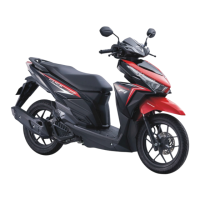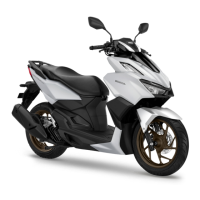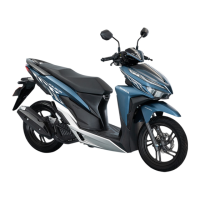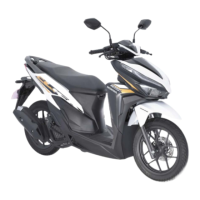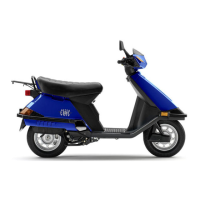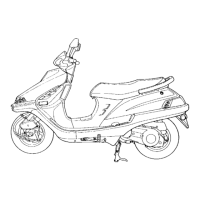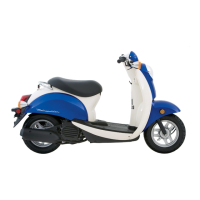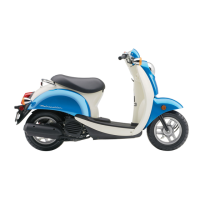Do you have a question about the Honda Click 125i 2019 and is the answer not in the manual?
Lists country codes and their corresponding countries for scooter models.
Explains DANGER, WARNING, and CAUTION signal words used in safety messages.
Guidelines to enhance rider safety, including inspections and riding practices.
Essential precautions for safe riding, including protective apparel like helmets and gloves.
Precautions for running-in, braking, wet conditions, and parking the scooter.
Advice on using approved accessories and avoiding unsafe modifications.
Guidelines on carrying extra weight, load limits, and securing luggage.
Ensuring the scooter is safe to ride by performing careful inspections before starting.
Procedure for starting and warming up the scooter's engine.
Steps to get on and begin riding the scooter.
Step-by-step instructions on how to open the fuel filler cap.
Procedure to verify the functionality of the scooter's digital display and segments.
Explanation of the speedometer which shows the vehicle's speed in km/h.
Indicates the amount of fuel remaining in the tank.
Shows the current time and how to set it.
Displays total distance, trip distances, average mileage, and battery voltage.
Control for signaling turns and cancelling turn signals.
Button to activate the scooter's horn.
Switch to select between high and low beam for headlights.
Activates or deactivates the Idling Stop system.
Button used to start the engine.
Switch to open the scooter's seat.
Buttons for anti-theft alarm and answer back system operation.
How to activate or deactivate the Idling Stop system using the switch.
Conditions required for the Idling Stop system to become ready.
Troubleshooting steps if the Idling Stop indicator fails to activate.
System that prevents starting with the side stand down.
Troubleshooting steps for engine starting issues.
Steps for starting the scooter and moving off, including checks and throttle control.
How to control speed using the throttle for acceleration and deceleration.
Instructions on how to open the scooter seat using the ignition key.
Procedure for closing and securing the scooter seat.
Explanation of why regular maintenance is crucial for safety and scooter longevity.
Essential safety guidelines to follow when performing maintenance tasks.
Checks to perform before riding to ensure safety and proper operation.
Guidelines for using genuine Honda parts for replacements to ensure safety.
Information on the maintenance-free battery and its servicing.
Criteria for choosing the correct engine oil based on standards.
Procedure for checking and maintaining correct tyre air pressure.
How to inspect tyres for cuts, slits, cracks, or embedded objects.
Checking tyre tread for signs of uneven or abnormal wear patterns.
How to check tread depth using wear indicators and when to replace tyres.
Procedure for removing and installing the scooter's battery.
Steps to check, clean, and gap the spark plug for optimal engine performance.
How to check the engine oil level using the dipstick.
Procedure for adding engine oil if the level is low.
Instructions for changing the engine oil and cleaning the oil strainer screen.
How to check the coolant level in the reserve tank while the engine is cold.
Procedure for adding recommended coolant to the reserve tank.
How to check the brake fluid level and inspect brake pads for wear.
Checking the condition of brake pad wear indicators and when to replace them.
Measuring and adjusting the freeplay of the rear brake lever.
Step-by-step guide to adjust the rear brake lever freeplay.
Checking the rear brake shoe wear indicator and when to replace shoes.
How to adjust the vertical aim of the headlights for proper alignment.
Steps to replace the battery in the remote transmitter for the alarm system.
Troubleshooting steps for when the starter motor operates but the engine does not start.
Troubleshooting steps for when the starter motor fails to operate.
Diagnosing and addressing engine overheating issues indicated by the coolant temperature warning.
Explanation of illuminated or flashing warning lights and their potential causes.
Interpreting other warning signals like fuel gauge failure.
Troubleshooting the Idling Stop system when it fails to function as expected.
Addressing issues where the engine doesn't stop with the Idling Stop system active.
Troubleshooting why the engine won't start even with the throttle open.
Guidance on emergency tyre repair and the risks involved.
Common electrical issues like dead battery, burned-out bulbs, and blown fuses.
Diagnosing intermittent unstable engine operation, possibly due to fuel pump filter clog.
Information on recording key numbers and making duplicates.
Care and handling instructions for the remote transmitter.
Overview of scooter instruments, controls, and additional features like document bag.
Guidelines for cleaning, polishing, and maintaining the scooter's appearance.
Recommended procedures for storing the scooter, especially for extended periods.
Safe methods for transporting the scooter, advising against towing.
Advice on environmentally friendly cleaning and waste disposal practices.
Location of frame and engine serial numbers for registration and parts ordering.
Information on using fuels blended with ethanol and potential risks.
How to protect the scooter's catalytic converter and its function.
Key physical dimensions, weight, and capacity specifications of the scooter.
Technical data for tires, spark plugs, fluids, and engine oil.
Recommended torque values for critical engine and chassis fasteners.
Information on the type of bulbs used for headlights and other lights.
Specifications for main and other fuses used in the scooter's electrical system.
| Bore x Stroke | 52.4 x 57.9 mm |
|---|---|
| Max Torque | 10.8 Nm @ 5, 000 rpm |
| Fuel System | PGM-FI (Programmed Fuel Injection) |
| Front Suspension | Telescopic Fork |
| Rear Suspension | Unit Swing |
| Wheelbase | 1, 280 mm |
| Seat Height | 769 mm |
| Curb Weight | 111 kg |
| Engine Type | Single-cylinder, 4-stroke, SOHC |
| Displacement | 124.9 cc |
| Max Power | 8.4 kW (11.4 PS) @ 8, 500 rpm |
| Ignition System | Full Transistorized Ignition |
| Starting System | Electric |
| Transmission Type | V-Matic |
| Front Brake | Disc Brake |
| Rear Brake | Drum |
| Rear Tire | 90/90-14 |
| Fuel Tank Capacity | 5.5 L |
| Front Tire | 80/90-14 |
